
7 min read
When I was younger, I used to think that the way to become wealthy was to get a high-paying job. I thought that the only way to earn money was to work for an employer and receive a paycheck. The higher the paycheck, the faster I could get rich.
I eventually learned that the type of income I thought lead to wealth had a name: earned income. This is income that you actively earn through doing work for someone else.
I also learned that this wasn’t the only type of income that you could earn, nor was it the best type for growing wealth.
In this post, I’ll share the three types of income that you can use to build wealth along with the benefits and drawbacks of each.
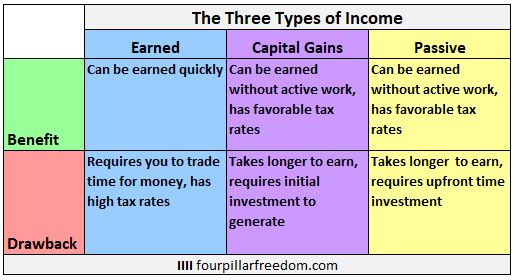
1. Earned Income
The first type of income is the most common: earned income. As I mentioned earlier, this is income that you receive in exchange for doing work for someone else. When you first start out on your financial journey, this is the only type of income that you’ll be able to earn. You will have to trade your time for money.
Examples
Examples of earned income include:
- Working as an hourly employee at a company.
- Working as a salaried employee at a company.
- Working as an hourly consultant for clients/companies.
- Working as an hourly or fixed-rate freelancer for clients/companies.
In each case, you are doing work for someone else in exchange for money.
Benefits
The main benefit of earned income is that you can earn it much faster compared to the next two forms of income that I’ll discuss. You will either receive payment for your work immediately once you finish or you’ll have to wait a few weeks at most.
For example, when I was a soccer referee in high school I would receive a cash payment as soon as the game ended. This is a classic example of earned income since I exchanged an hour of my time in return for $25.
Perhaps the most common example is being an employee at a business. Whether you’re hourly or salary, you likely get paid every week, every two weeks, or every month. This is the benefit of earned income: you can receive it fairly quickly.
Drawbacks
There are a couple clear drawbacks to earned income.
1. You have to sacrifice your time to receive it. If you want to earn your paycheck from your employer, you’ll have to work for eight hours or more five days per week. This often includes time spent commuting and potentially answering texts and emails even after you’ve left the office.
If you love your job, this time commitment might not seem like a sacrifice. Sadly, a recent International Gallup poll found that just 15% of the world’s one billion full-time workers are engaged at work. That means 85% of people aren’t thrilled about how they’re spending 8+ hours per day through the week. Simply put, most people don’t enjoy exchanging their time for money.
And once you quit working, your income will dry up. Even for individuals in high-paying professions like doctors and lawyers, if their only source of income is earned income, then they’ll have no money coming in the door once they decide to take a break or stop working altogether.
2. Earned income has high tax rates relative to other forms of income. The following table from Tax Foundation shows the tax rates for various income levels as of 2019:
| Rate | For Unmarried Individuals, Taxable Income Over | For Married Individuals Filing Joint Returns, Taxable Income Over | For Heads of Households, Taxable Income Over |
|---|---|---|---|
| 10% | $0 | $0 | $0 |
| 12% | $9,700 | $19,400 | $13,850 |
| 22% | $39,475 | $78,950 | $52,850 |
| 24% | $84,200 | $168,400 | $84,200 |
| 32% | $160,725 | $321,450 | $160,700 |
| 35% | $204,100 | $408,200 | $204,100 |
| 37% | $510,300 | $612,350 | $510,300 |
Along with taxes you’ll have to pay Medicare and Social Security, which means a decent chunk of the income you earn won’t actually land in your pockets.
2. Capital Gains Income
The next type of income that you can earn is called capital gains income. This is income you receive from selling an investment for more than the amount you paid for it (this is also sometimes called “portfolio income”). The formula to calculate capital gains is simple:
Capital gains = Selling price – Purchase price
Examples
The most classic example of capital gains income is buying a stock for a certain price and selling it at a later date for a higher price.
For example, suppose you buy $1,000 worth of shares in a stock index fund that eventually appreciate in price to $1,500. If you decide to sell those shares, you will have earned $500 in capital gains income.
Whenever you sell an asset for more than the price you bought it at, you will receive capital gains income. Some other examples of assets you might sell include bonds, precious metals and real estate.
Related: 19 Income Producing Assets to Build Wealth
Benefits
Earning income through capital gains has a couple clear benefits:
1. It’s mostly passive. In most cases, it doesn’t require active work for you to obtain capital gains income. For example, if you buy shares in a stock index fund and sell them two years later at a higher price, you would receive income without actually doing anything to earn it. You merely benefited from holding your shares and being patient.
2. This type of income is taxed more favorably than earned income. When you earn capital gains income, you will have to pay capital gains taxes. However, these are lower than earned income taxes.
The amount of capital gains tax you’ll pay is dependent on your ordinary income as well as how long you held an asset before you sold it.
You’ll have to pay short-term capital gains taxes if you sell an asset after owning it for less than a year, which are equivalent to ordinary income tax rates. However, if you sell an asset at a higher price after owning it for more than one year, you will instead pay long-term capital gains taxes.
The following table shows the 2019 capital gains tax rates based on your ordinary individual income:
| Long-term capital gains tax rate | Ordinary individual income |
|---|---|
| 0% | $0 to $39,375 |
| 15% | $39,376 to $434,550 |
| 20% | $434,551+ |
The following chart from the Tax Policy Center illustrates how long-term capital gains taxes are lower than individual income taxes, and have been since 1954:
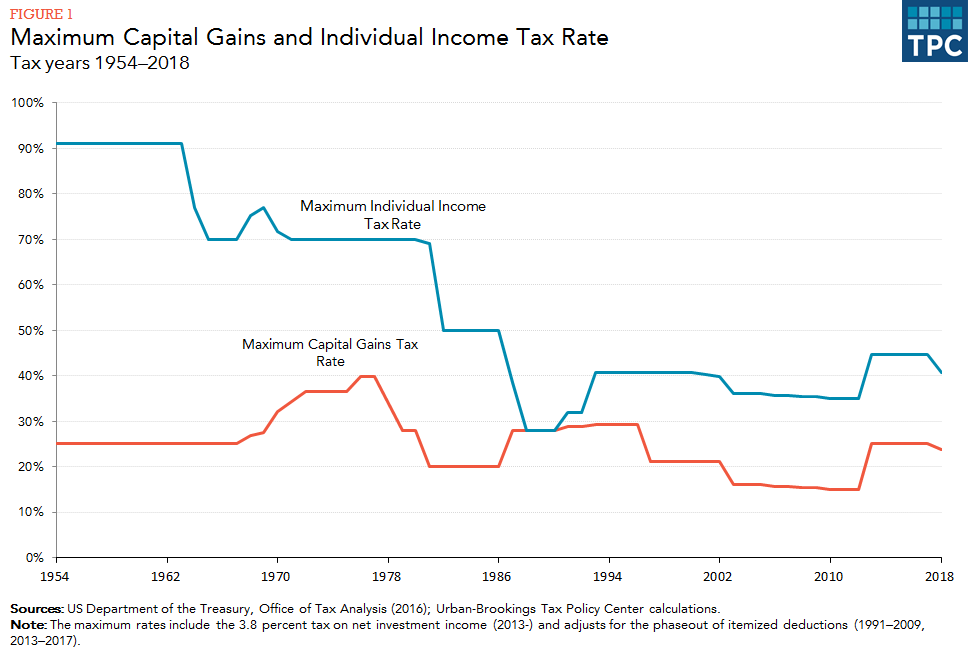 So, capital gains offer a more passive and tax-favorable way to earn money compared to earned income.
So, capital gains offer a more passive and tax-favorable way to earn money compared to earned income.
Drawbacks
The main drawback of earning capital gains income is that it requires you to have existing money to actually invest in assets like stocks, bonds, and real estate that have the potential to appreciate in price. As opposed to earned income, it takes much more time to start accumulating capital gains income.
For example, suppose you’re able to invest $10,000 in shares of a stock index fund over the course of one year. Suppose those shares appreciate in price to $12,000 over the next two years. You could then sell them for a $2,000 capital gain and walk away with about $1,700 after long-term capital gains taxes (assuming your individual income is between $39k and $434k).
While that’s a passive way to earn income, it’s not a huge amount of money and it likely took several months or years to accumulate the $10,000 needed for your initial investment.
3. Passive Income
The final type of income that you can earn is called passive income. This is income that you earn from owning assets that requires no work on your part.
Examples
There are tons of different examples of assets that you could own to generate passive income. Check out this list of 19 different income-generating assets that can invest in if you’re looking for some ideas. Some of the more common examples include:
Dividend-paying stocks: When a company generates profits, they can decide to reinvest those profits back into the business to grow it further or they can pay out some of the profits in the form of dividends to investors. When you invest in a stock (or stock index fund) that pays dividends, you can receive a dividend payment every three months.
Rental properties: You can earn income in the form of rent payments from a rental property that you own. You can either buy a house specifically to rent it out or simply rent your own house when you decide to move instead of selling it.
REITs: A REIT (real estate investment trust) is a company that owns income-producing properties. When you invest in a REIT, you receive dividend payments either every month or every three months. This is one simple way to earn rental property income without enduring the headaches that often come with owning physical property.
Crowdfunded real estate: Another popular way to earn income from real estate is to invest in crowdfunded real estate deals. Instead of investing in a property by yourself, you can instead invest in properties with thousands of other people online, which is a hands-off approach that you can use to invest in real estate without dealing with any property management. My personal favorite platform for investing in crowdfunded real estate is Crowdstreet.
Websites: A website can offer passive income if you’re able to drive free recurring traffic to your site through SEO and monetize that traffic using banner ads, affiliate links, your own products, sponsorships, and memberships. If you’re looking to set up your own website, check out my quick-start guide here.
In each of these examples, you own an asset that produces income for you.
Benefits
The benefit of passive income is that you don’t have to sacrifice your time to earn it. Instead, the assets that you own are able to produce income for you while you sleep.
Drawbacks
Passive income has the same drawback as capital gains income: it requires existing money to generate it. It’s wonderful to own $10,000 worth of stock index funds that produce $300 in dividends annually, but it takes time to accumulate that $10,000 for the initial investment.
In addition, if you earn passive income from something you create from scratch like a website or small business, this requires a huge time commitment up front. Something I often tell people is that “it takes a lot of active work to generate passive income.”
How to Transition Away from Earned Income
Everyone must trade time for money when they first start on their financial journey. However, the only people that have to keep trading time for money are the ones who never acquire assets that are able to produce capital gains income or passive income. Without assets, these people must continue to sacrifice their time in order to receive the income they need to pay the bills.
Consider the following example of a 23-year-old who starts their career with a post-tax salary of $35,000 and is able to grow their income by 5% each year, yet spends all of their income each year up through their mid-forties without acquiring any assets:
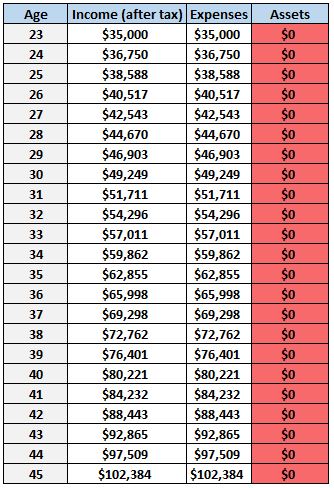
Despite increasing their income consistently each year, they never actually gain the financial freedom needed to step away from their job or take a break since they lack assets that can generate income for them:
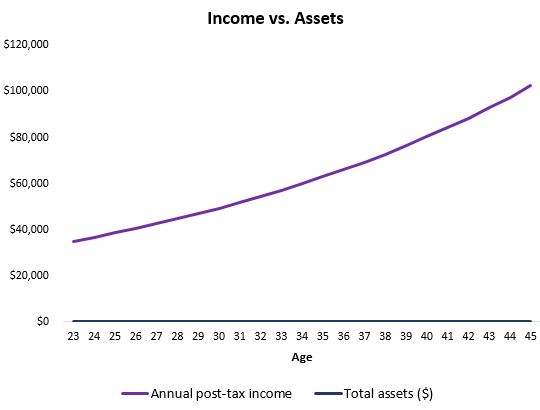
Instead, consider the same individual who decides to invest 20% of their post-tax annual income into assets that grow at a rate of 5% each year through their mid-forties:
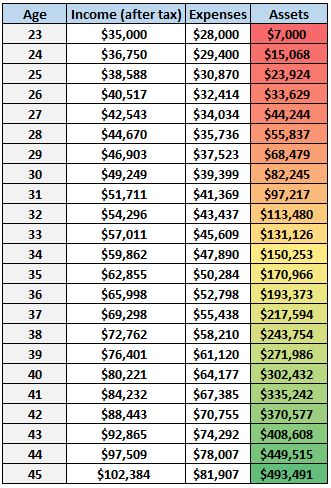
Despite inflating their lifestyle and yearly spending each year, because they invested 20% of their yearly income they would be able to accumulate over $493k in assets by their mid-forties.
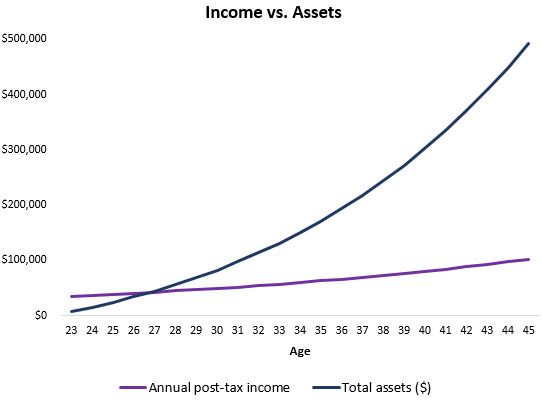
Even if this isn’t enough to be financially independent, it does give an individual the ability to walk away from a shitty job, pursue part-time work, or take extended time off.
Conclusion
Everyone is dependent on earned income when they first start on their financial journey, but the way to gain freedom from this dependency is to acquire assets that can produce capital gains or passive income for you.
First, work for money.
Then, make money work for you.
- The Ad Revenue Grid - August 6, 2021
- Attract Money by Creating Value for a Specific Audience - July 13, 2021
- The 5-Hour Workday - March 26, 2021
Full Disclosure: Nothing on this site should ever be considered to be advice, research or an invitation to buy or sell any securities, please see my Terms & Conditions page for a full disclaimer.
